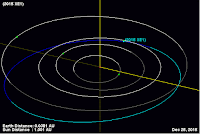Asteroid
2015 YV9 passed by the Earth at a distance of 3 602 000 km (9.37 times
the average distance between the Earth and the Moon, or 2.4`% of
the average distance between the Earth and the Sun),
slightly after 3.00 pm GMT on Saturday 26 December 2015. There was no
danger
of the asteroid
hitting us, though had it done so it would have presented only a minor
threat. 2015 YV9 has an estimated equivalent diameter of 14-43 m (i.e.
it is estimated that a spherical object with the same volume would be
14-43 m in diameter), and an object of this size would be expected to
explode in an airburst (an explosion caused by superheating from
friction with the Earth's atmosphere, which is greater than that caused
by simply falling, due to the orbital momentum of the asteroid) in the
atmosphere between 28 and 10 km above the ground, with only fragmentary
material reaching the Earth's surface.
2015 YV9 was discovered on 30 December 2015 (four days after its closest approach to the Earth) by the University of Arizona's Catalina Sky Survey,
which is located in the Catalina Mountains north of Tucson. The
designation 2015 YV9 implies that it was the 246th asteroid (asteroid V9)
discovered in the second half of December 2015 (period 2015 Y).
2015 YV9 has an 1135day orbital period and an eccentric orbit tilted at
an angle of 6.16° to the plane of the Solar System that takes it from
1.01 AU from the Sun (i.e. 101 % of the average distance at which the
Earth orbits the Sun) to 3.25 AU from the Sun (i.e. 325% of the average
distance at which the Earth orbits the Sun, over twice times the
distance at which the planet Mars orbits). It is therefore classed as an
Amor Group Asteroid (an asteroid which comes close to the Earth, but
which is always outside the Earth's orbit).
See also...
 January's first meteor shower: The 2015 Quadrantids. The Quadrantid Meteor Shower is one of the brightest meteor showers of
the year, often producing over 100 meteors per hour at its peak, which
falls on the night...
January's first meteor shower: The 2015 Quadrantids. The Quadrantid Meteor Shower is one of the brightest meteor showers of
the year, often producing over 100 meteors per hour at its peak, which
falls on the night... Asteroid 2015 XA378 passes the Earth. Asteroid
2015 XA378 passed by the Earth at a distance of 3 857 000 km (10.0times
the average distance between the Earth and the Moon, or 3.40% of
the average distance between the Earth and the Sun),
slightly after 7.15 pm GMT on Saturday 19...
Asteroid 2015 XA378 passes the Earth. Asteroid
2015 XA378 passed by the Earth at a distance of 3 857 000 km (10.0times
the average distance between the Earth and the Moon, or 3.40% of
the average distance between the Earth and the Sun),
slightly after 7.15 pm GMT on Saturday 19... Asteroid 2015 XE1 passes the Earth. Asteroid
2015 XE1 passed by the Earth at a distance of 5 080 000 km (13.2
times the average distance between the Earth and the Moon, or 3.40% of
the average distance between the Earth and the Sun),
slightly before 3.00 am GMT on Saturday 19 December 2015...
Asteroid 2015 XE1 passes the Earth. Asteroid
2015 XE1 passed by the Earth at a distance of 5 080 000 km (13.2
times the average distance between the Earth and the Moon, or 3.40% of
the average distance between the Earth and the Sun),
slightly before 3.00 am GMT on Saturday 19 December 2015...
Follow Sciency Thoughts on Facebook.

